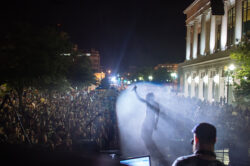Festival International de Louisiane
The festival celebrates southwest Louisiana’s connections to the francophone world.

Wikimedia Commons
Pierre Kwenders, a Congolese-Canadian singer, songwriter, and DJ, performing at Festival International de Louisiane, 2016. Festivalinternational, photographer.
Launched in 1987, Festival International de Louisiane in Lafayette attracts three hundred thousand visitors annually from nearly every US state and more than two dozen countries. A nonprofit, free festival staged in April, it is the largest international music festival in the United States. In addition to Cajun-French, Creole, and zydeco music from Louisiana, the festival’s performances on multiple stages feature music from Canada, France, Belgium, Africa, and other French-speaking nations. Festival International makes an estimated $49 million annual economic impact on the Lafayette area.
Impetus for the creation of Festival International included the 1980’s economic crisis caused by a dramatic drop in oil and natural gas prices. In 1986 Louisiana’s unemployment rate reached 13.2 percent, the highest in the nation. Even before the crisis, downtown Lafayette, echoing nationwide trends, experienced a 60 percent vacancy rate. In 1978 the city launched its Community Development Department to address the issue. The department’s action plan for revitalization included the creation of a downtown festival.
Other initiatives, ideas, and support converged to establish a festival in downtown Lafayette: the Cajun-French music and culture renaissance that began in 1970s; Urban Development Action Grants from the US Department of Housing and Urban Development; and advocacy for a festival from the city’s first Downtown Development Authority director, Lloyd Gardner, a New Orleans native who loved his hometown’s New Orleans Jazz & Heritage Festival.
In 1985 Herman Mhire, director of the University Art Museum at the University of Louisiana at Lafayette, began his quest to stage a visual and performing arts festival. A succession of experiences that year inspired him, including the museum’s exhibition of paintings by artists from Senegal and traditional music performances by Senegalese musicians. Mhire was also influenced by a Festival of India he attended in Amsterdam. In the fall of 1985 Mhire participated in meetings with Phillip Arleigh Lank, director of Community Development for Lafayette; Philippe Gustin, director of CODOFIL (Council for the Development of French in Louisiana); Jean Goyer, director of the Bureau du Québec in Lafayette; and other local officials. The province of Québec subsequently volunteered to host Lafayette officials at three of its festivals. Lank dubbed the visits to the Montreal Jazz Festival, Festival Folkloric du Drummondville, and Festival d’été de Québec in Québec City as “festival school.”
The Lafayette officials picked Festival d’été de Québec as the model for their city’s festival. Lank cited it as “the perfect example of what we were seeking, a multi-faceted festival—music, art, food, theatre, film, street animation and an area set aside just for kids. And it all took place in downtown Québec City, using multiple open-air stages.” Mhire, who is credited as Festival International’s “conceptual visionary,” served as the new Lafayette festival’s founding president. In the festival’s mission statement, Lank cited the event’s goal as “celebrating the French cultural heritage of our area with emphasis on highlighting our connectivity with the francophone world.”
On July 2, 1987, the first Festival International de Louisiane opened with a ceremony at Lafayette city hall. Flags representing the participating nations flew as local and international officials spoke, and a statue by French sculptor Charles Correia of the Marquis de Lafayette, the French hero of the American Revolution, was unveiled.
A parade to the inaugural festival’s main stage included marchers wearing festive decorative heads on loan from Blain Kern’s Mardi Gras World in New Orleans. Following the parade were performances by the Wild Magnolias Mardi Gras Indians from New Orleans and, setting the festival’s international tone, the Rwanda Master Drummers. The ensuing three days of performances featured talent from Canada, France, Guinea, Benin, Senegal, and Belgium. Performers from Louisiana included Cajun musicians Dennis McGee, Sady Courville, Wayne Toups, and Michael Doucet; zydeco musician Terrance Simien; and Baton Rouge blues singer-pianist Henry Gray. The first festival featured the Pavillon de Cuisine’s international fare prepared by thirty chefs. Seven-hundred and fifty volunteers helped stage the event.
In its second year Festival International moved from the hot month of July to late April. The number of stages expanded through the years, and performers beyond French-speaking nations were added to the lineup. The 2022 schedule featured performers from Jamaica, Cuba, Ukraine, Guadeloupe, and Morocco, as well as the French-speaking nations of Mali, Haiti, Belgium, Republic of the Congo, and Canada.
Festival International presented only virtual performances in 2020 and 2021 due to the coronavirus pandemic. In 2023 the festival joined the Lafayette Parish Bicentennial and Lafayette Convention and Visitors Commission to present former Lafayette resident Lauren Daigle, a Christian music star who crossed over to mainstream stardom. That year also saw the return of festival favorite Angélique Kidjo from Benin.
